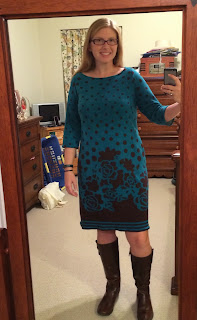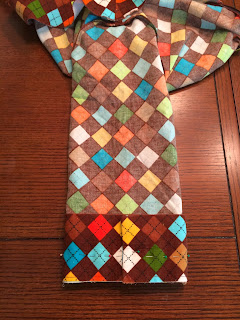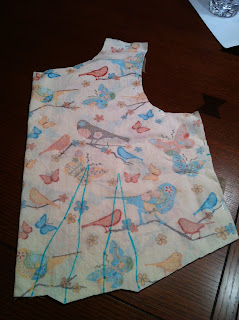New Look 6145, View B
It seems like every time I promise "no more fabric," the
So instead of starting on my intended project (another Rockstar Jacket), I took a few days to tackle my knit.
I chose a simple shift to showcase the design on the fabric. New Look 6145 stated that it was suitable for knits, although gave no suggestions as to how to proceed any differently with a knit. I do not have much experience at all with knits, but it seemed at least a few changes would be required. I made a few "educated" guesses and got to cutting.
The cutting took forever, as the design was not symmetrical and hard to line up. Plus the material was stretchy and slippy so that added an extra challenge. Once I finally got the material laid out, here are the pattern changes I made:
Pattern changes:
I increased the length of the hem, just a personal preference. I ended up not needing the extra length. This material was rather weighty and, combined with the stretch, this led to some sagging.. What I didn't take into account was that when I cut off all that extra fabric after hemming, the dress would then creep back up a little. This was not a huge problem, as I had hemmed the dress at the knee, but good to remember for the future. This did also help with the placement of the design. I felt the brown design started too low on my torso during early fittings even after careful pattern layout, but once the extra weight was removed, it sprang back closer to the desired location. Again, good to remember for next knit project... This pulling did also require an additional 5/8" adjustment at the shoulders to move the armholes, neck and darts back to the correct position. This was fine even after removing the excess weight.
I added extra allowance at the neck to allow room for a narrow hem since I had decided not to use a facing. I am not sure if this is how it should be done, but having never seen a sweater knit with a facing, I decided to leave it out. This ended up working out just fine.
I added a little extra at allowance at the waist and hip just in case the fit was snug. This turned out to be unnecessary as there was plenty of stretch in the material. I ended up removing the extra material at the allowances, deepening my side seam by 5/8" under the arms and tapering to the waist and enlarging the back darts by a total of 1" at my first fitting. I also removed an extra 1" at the top of the shoulder/sleeve, tapering to an extra 1/2" at the bottom of the armhole to correct some bunching and pull the shoulder seams up to the correct location.
 |
| Dress after fitting and marking |
 |
| Changes to shoulder seams |
Also, since the fabric had a 50% stretch, I decided to omit the zipper, center back seam and back vent that was called for in the woven pattern. I simply cut the back on the fold. (I did allow the pattern to hang over the fold by 5/8" since I would not need that seam allowance at center back). This worked out great.
 |
| Dress Front before fitting |
 |
| Dress Side before fitting |
 |
| Dress Front after fitting |
 |
| Dress Side after fitting |
Overall, I am pretty pleased with the dress. Construction (including complete basting of the bodice for fitting and marking and the tedious removal of all those seams) only took 2 days worth of naptimes and a couple of hours both nights. This may be record time for a sewing project at this house. The dress is also the most comfortable that I have made. I may do some research before another knit project as I'm not entirely thrilled with my seam allowances. They don't lie down nicely in some places, adding some unneeded bulk at the hip and occasionally bunching under the shoulder. Also, despite knowing I needed to use stabilizer when top stitching the bottom hem, I skipped it and ended up with the dreaded "wavy seam syndrome". (More on WSS) As much as the wavy hem bothers me, I have decided (at least for now) not to go to the trouble of ripping out all those tiny stretch stitches... However, if I ever decide to take this on, I now have the perfect shirt:







































